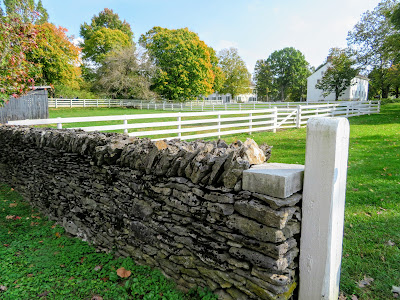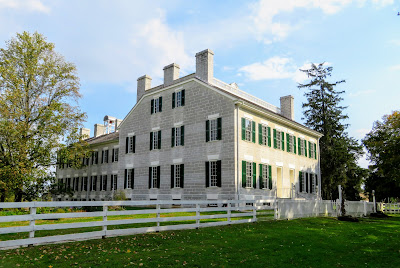After our disappointment regarding the lack of Sunday shopping in Berea Kentucky, we headed toward our next Lexington area attraction. We drove along a number of scenic back roads west from Berea through Lancaster and Danville and then up KY Hwy 33 to Pleasant Hill and its historic Shaker Village…
The Shaker Village of Pleasant Hill was the location of a Shaker religious settlement that was active for over 100 years. Formally known as the United Society of Believers in Christ’s Second Coming, the Shakers originated in Great Britain ca. 1750, with the first Shakers immigrating to North America in 1774. The sect was originally known as the “Shaking Quakers” because of the intensity of their behavior during their services.
The
Shakers believed in communal ownership of property and the equality of race and
sex. They also opposed marriage and practiced
celibacy. Of course the latter practice
made the recruitment of new community members a necessity or eventually any Shaker
settlement would disappear.
In 1805,
a group of Shakers moved west to central Kentucky and they established Pleasant
Hill on a hill along the Kentucky River.
Today the former Pleasant Hill Shaker settlement is a major tourist attraction. Visitors enter the village through the former Carpenter’s Shop which was built in 1815. This building was first used as a blacksmith and wagon makers’ shop, becoming a carpenters’ workshop in 1843. By 1885, this was a broom shop.
Today this
is where visitors purchase tickets, peruse a number of displays and do some
shopping. Laurie and her sister Bonnie finally had a chance to shop and they bought a few items. I took them back to our car before we began our self-guided
tour.
We loved this rock wall as well as the overall pastoral feeling of the village. The wall reminded Laurie and I of the short time when we lived in Massachusetts and of our many back road adventures in New England.
Pleasant
Hill reached its zenith in the 1820s.
There were about 600 residents, 2,800 acres of farmland and 250
structures. By the 1860s the Shaker
community began to decline. There were
several causes for this problem…the advent of the American Civil War, changing
social attitudes and the beginning of the Industrial Revolution…all making it
difficult to attract new members for the community. The fact that they considered sex to be a sin
was probably the key factor though…
This large and handsome structure is the Centre Family Dwelling. It was built between 1824 and 1834. Up to 100 Shakers, who lived as brothers and sisters, lived here on opposite sides of the building. There are 14 bedrooms, kitchens, a dining room, a cellar for food storage, an infirmary and a large meeting room.
One
individual, Micajah Burnett, had a major influence on the architecture at
Pleasant Hill. Burnett arrived here with
his parents in 1809 when he was 17 years old.
By 1815 he was helping create the layout of the village. Using local rock, clay and wood, and
following the architectural guidance prescribed by the Shaker ministry, he
designed the village’s buildings in the Federal Style. The interior concept focused on maximizing
space, minimizing the need for supports and allowing for large open interior
rooms.
Both the women’s and men’s sleeping quarters were definitely minimalist. Personal possessions were few in this communal society. All dwellings were segregated by sex, as were women and men’s work areas.
When it was time for breakfast, lunch or dinner, the village residents would enter this room at the sound of 2 bells. Brothers came in from the east door and Sisters through the west door. Everyone ate in silence. Sisters always set the tables in such a manner that diners could avoid having to pass food thereby eliminating excess noise. Meals were a time of reflection…
By the
1790s, Shakers had developed written covenants for their members. If you signed the covenant, you had to
confess your sins, pledge your property and labor to the society, and live as
celibates. If you were married before
joining the society, those marriages ended when the couple joined.
This pine cupboard is one of the many pieces of Shaker furniture on display at Pleasant Hill. It was built ca. 1850. The cupboard probably came from the Mount Lebanon Shaker community that was located a few miles southeast of Albany New York.
Shaker
furniture is known for is austere, clean lines.
Shaker craftsmanship was based on design principles of truth to material
and form follows function. This
aesthetic has endured with Shaker style furniture available and popular
nation-wide.
Antique
Shaker furniture is in high demand even today.
Chairs were the most common items but now even a chair can cost
somewhere from $500 to $1000…depending on condition. A Shaker dresser can cost as much as $45,000.
This bonnet was made by Mary Settle, the last living Shaker from “Shakertown”, the Pleasant Hill Community. It was given to a local resident’s mother and loaned to the Pleasant Hill museum. The card in front of the bonnet points out that it not only won a blue ribbon in the county fair, but also at the State Fair! Mary Settle died in 1923.
This is Pleasant Hill’s “Meeting House”. It was built in 1820 and it was the spiritual center of the Shaker community. Worship services were held on the first floor and apartments for the Ministry were on the second floor. Note the two entrances. Sisters entered through one door and Brothers entered through the other.
Of course, once the worshippers entered the area for their religious services, they sat on opposite sides of the room.
This picture is a 1870s depiction of a Shaker service in the Lebanon New York Shaker community. It was published by Currier and Ives.
Shaker
were so-called because of their practices of shaking, dancing and whirling in
addition to speaking, shouting and singing “in tongues”. However, later services were more orderly and
included choreographed dances, songs, marches and gestures.
After the Shakers were gone, the buildings and property passed into private hands. The Shakers were nearly forgotten. One building became a restaurant, one was used as a gas station and another became a general store. The Meeting House was originally converted for use as an automotive garage. Its floor, built to withstand several hundred brethren and sisters, was strong enough to support vehicles entering the structure. As you can see from the sign shown above, after the Meeting House’s use as a garage, it was converted again, this time for use as the “Shakertown” Baptist Church.
Our visit
to the Pleasant Hill Shaker Village will be continued in my next post… Just
click on any of the photos to enlarge them.
Thanks
for stopping by for a visit!














Looks like an interesting place but I can't imagine them viewing sex as a sin if they used the Christian Bible.
ReplyDeleteInteresting! I am glad that Laurie and her sister Bonnie finally got some shopping done :-)
ReplyDeleteWhat great craftsmanship! Both in buildings (still standing) and furnishings. I dare say the clothing was all stitched by the women. Men probably farmed, so there must be some barns as well. Looking forward to seeing more tomorrow.
ReplyDeleteThanks for the information about the Shaker community, Dave. We visited one here in New England last year and much of what the guide told us was the same as you posted here. We saw a building with the separate men and women entrances and heard how they practiced celibacy upon joining.
ReplyDelete